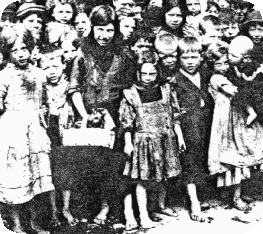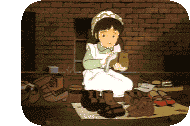Against child labour


While it may be hardly believable from a modern view that working children have been constantly ill-treated as depicted in 'A Little Princess Sara', it is a well-known fact that the situation of children from the lower social class in the 19th century was often far worse, especially in the first half. This was the case not only in Great Britain but in almost every other European country although the United Kingdom is supposed to be the most fitting example because it is the very birthplace of the Industrial Revolution.
 This page wants to tell you some historical background information on
child labour throughout the 19th century as well as the situation today.
I have also tried to get an idea of everyday life of the people at that
time and of their psychological background. At the end of this page you will
find two links pointing to sites with further information on the present
situation.
This page wants to tell you some historical background information on
child labour throughout the 19th century as well as the situation today.
I have also tried to get an idea of everyday life of the people at that
time and of their psychological background. At the end of this page you will
find two links pointing to sites with further information on the present
situation.
 The beginning of the industrial age brought a new social
gap to society in Great Britain. The rich entrepreneurs on one side, the
working class, among them the poorest of the poor, on the other side. As it
happens with all technological innovations, technological progress is only
slowly followed by social progress. In this case many poor people had to
suffer and bear hardships for a long time until a better understanding of
the social problems caused by uncontrolled capitalism led to social reforms
and a fair chance for everyone. But at the beginning of the 19th century,
the working people were almost completely dependent on their employers,
bound by the need of money for a living. And children were no exception.
The beginning of the industrial age brought a new social
gap to society in Great Britain. The rich entrepreneurs on one side, the
working class, among them the poorest of the poor, on the other side. As it
happens with all technological innovations, technological progress is only
slowly followed by social progress. In this case many poor people had to
suffer and bear hardships for a long time until a better understanding of
the social problems caused by uncontrolled capitalism led to social reforms
and a fair chance for everyone. But at the beginning of the 19th century,
the working people were almost completely dependent on their employers,
bound by the need of money for a living. And children were no exception.
 Children did all kinds of work. They worked in factories, in cotton and
weaving mills, at farms, in foreign households as servants, in manufactures
and even in collieries and mines. Many children also sold all kinds of things
in the streets. Almost every job was tedious and exhausting monotony because
children are not able to do more complicated jobs of course. Some work could
only be done by children because of their small size. The duration of a work
day depended on their employers. But a 12 hour day was very common. In some
cases it was even 15 hours long. The breaks and eventually nutrition were also
dependent on the employers. Work life startet at an early age, usually at 8
or 9. But there are many cases were children started working at 6 or even
earlier.
Children did all kinds of work. They worked in factories, in cotton and
weaving mills, at farms, in foreign households as servants, in manufactures
and even in collieries and mines. Many children also sold all kinds of things
in the streets. Almost every job was tedious and exhausting monotony because
children are not able to do more complicated jobs of course. Some work could
only be done by children because of their small size. The duration of a work
day depended on their employers. But a 12 hour day was very common. In some
cases it was even 15 hours long. The breaks and eventually nutrition were also
dependent on the employers. Work life startet at an early age, usually at 8
or 9. But there are many cases were children started working at 6 or even
earlier.
 The government has taken several steps to improve the situation. Various
acts have been passed by the parliament, for example the two Factory Acts
1819 and 1833, the Gangs Act 1867 and the Education Act 1876. The main
intention was to prohibit work of children under a certain age. The Factory
Act 1819 as an example prohibited work of children under 9(!) years old in
factories and cotton mills. Schooling became also more important, especially
in the latter half of the 19th century. It was realized that education was a
more proper way to prepare children for their later life. Not only the
government but also some private people got more and more concerned about the
problem. A nice example is the Liverpool Society for the Prevention of
Cruelty to Children founded in 1883 who fought against excessively hard
punishments such as regular beatings and immersion in cold water as practiced
at many workplaces as well as cruelty of parents to their children. The
government reacted in 1889 and passed the Prevention of Cruelty to Children
Act.
The government has taken several steps to improve the situation. Various
acts have been passed by the parliament, for example the two Factory Acts
1819 and 1833, the Gangs Act 1867 and the Education Act 1876. The main
intention was to prohibit work of children under a certain age. The Factory
Act 1819 as an example prohibited work of children under 9(!) years old in
factories and cotton mills. Schooling became also more important, especially
in the latter half of the 19th century. It was realized that education was a
more proper way to prepare children for their later life. Not only the
government but also some private people got more and more concerned about the
problem. A nice example is the Liverpool Society for the Prevention of
Cruelty to Children founded in 1883 who fought against excessively hard
punishments such as regular beatings and immersion in cold water as practiced
at many workplaces as well as cruelty of parents to their children. The
government reacted in 1889 and passed the Prevention of Cruelty to Children
Act.
Those acts were not too successful in the beginning. They were difficult to
supervise and often factory owners were able to get around them. However, as
time went by, the acts took more and more effect and the amount of child
workers constantly declined or shifted to easier jobs. Girls once worked as
hard as their male counterparts in factories and mines. In the latter part
of the century, more girls worked in households rather than in the industry.
And Sara and Becky were two of them.
Detailed informations about everyday life of the working class in the 19th century are very scarce. The following is a brief description of my understanding of the situation at that time based on some tidbits of information I have. There are actually two important psychological aspects: the children themselves and their masters as well as the rest of the upper class.
 The poor families were dependent on the work of their children. This means
that children started working at young age and effectively spent almost their
whole childhood at the place of work. In the long term, this is a greater loss
than the missed financial support if the children had lived a "normal"
childhood as we know it today. In the growing up phase of a child, its
experiences and the influences from its social environment play an important
role. They help to establish a better understanding of greater contexts and
to develop social competence. But what if those experiences are reduced to
some simple movements which must be repeated monotously on and on under the
suspicious eyes of an overlooker? With most of the children growing up without
being able to do more complex jobs and no hopes for a better life, it is almost
impossible to break through the vicous circle of poverty and lack of education.
Servants like Sara and Becky actually were in a somewhat better situation than
the children working in factories and similar places.
The poor families were dependent on the work of their children. This means
that children started working at young age and effectively spent almost their
whole childhood at the place of work. In the long term, this is a greater loss
than the missed financial support if the children had lived a "normal"
childhood as we know it today. In the growing up phase of a child, its
experiences and the influences from its social environment play an important
role. They help to establish a better understanding of greater contexts and
to develop social competence. But what if those experiences are reduced to
some simple movements which must be repeated monotously on and on under the
suspicious eyes of an overlooker? With most of the children growing up without
being able to do more complex jobs and no hopes for a better life, it is almost
impossible to break through the vicous circle of poverty and lack of education.
Servants like Sara and Becky actually were in a somewhat better situation than
the children working in factories and similar places.
With the rising importance of schooling the situation improved greatly over
the time. Some rare employers even set up own schools which dealt with the
education of the company's child workers.
 But usually the masters were rather ignorant of those social problems.
The children were just another resource of cheap work power. Beside that
they were of rather low interest, which is the reason for another serious
problem. The employers were interested in a constant performance in exchange
for their money as you would expect from an adult worker. But something like
that cannot be expected from a child. So they relied on various disciplining
actions. Exactly these were responsible for the sometimes unbearable working
conditions for the children. Punishments were of course a part of them and
targets with threatening consequences if they were not reached.
But usually the masters were rather ignorant of those social problems.
The children were just another resource of cheap work power. Beside that
they were of rather low interest, which is the reason for another serious
problem. The employers were interested in a constant performance in exchange
for their money as you would expect from an adult worker. But something like
that cannot be expected from a child. So they relied on various disciplining
actions. Exactly these were responsible for the sometimes unbearable working
conditions for the children. Punishments were of course a part of them and
targets with threatening consequences if they were not reached.
The (rich) general public was also too separated from the poor people that
they had very little knowledge of the circumstances in London East End for
example, besides that the people there are poor. Interest in the problems of
the poor rose only slowly, starting with a few engaged individuals. A nice
example of the slow progress on this field is the Prevention of Cruelty to
Children Act mentioned above, which was ironically passed many years after a
very similar act that protected animals. But the higher standards today have
their roots in this first little steps in the right direction.
Ivy Pinchbeck, Margaret Hewitt
Children in English Society Vol. 2
London, Routledge & Kegan Paul, 1973
ISBN 0-7100-7580-4
Thomas E. Jordan
Victorian Childhood
State University of New York Press, Abby, 1987
ISBN 0-88706-544-9
James Walvin
A Child's world
Penguin Book Ltd., 1982
ISBN 0-1402-238-9 (???)
Sadly I could not get access to this one:
John Brown
A memoir of Robert Blincoe
Firle Sussex, Caliban Books, 1977
ISBN 0904573052
The problem of child labour is still present. Not in the great industrial nations, they must fight against new problems now, but in some other countries like India for example (how ironic) or Asian and African countries. The estimated number of children who work full day is about 120 million. The circumstances are basically very similar to those described above with some further problems like child prostitution. The following two links should give more useful information on child labour today.
Child labour section at UNICEF
The UNICEF has published several papers on child labour. All are freely downloadable from this site in plain text or Adobe Acrobat formats. There is also an interactive quiz to test your knowledge.
The International Labour Organization (ILO) has formed an own division dealing with the problem of child labour, the IPEC (International Programme on the Elimination of Child Labour). This page contains many facts for the interested.